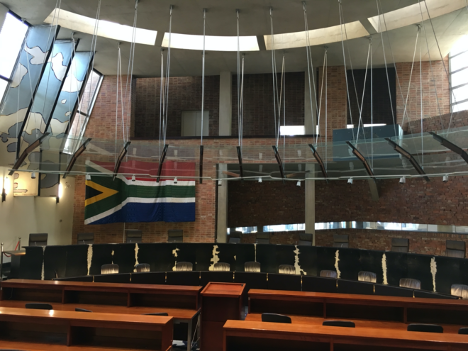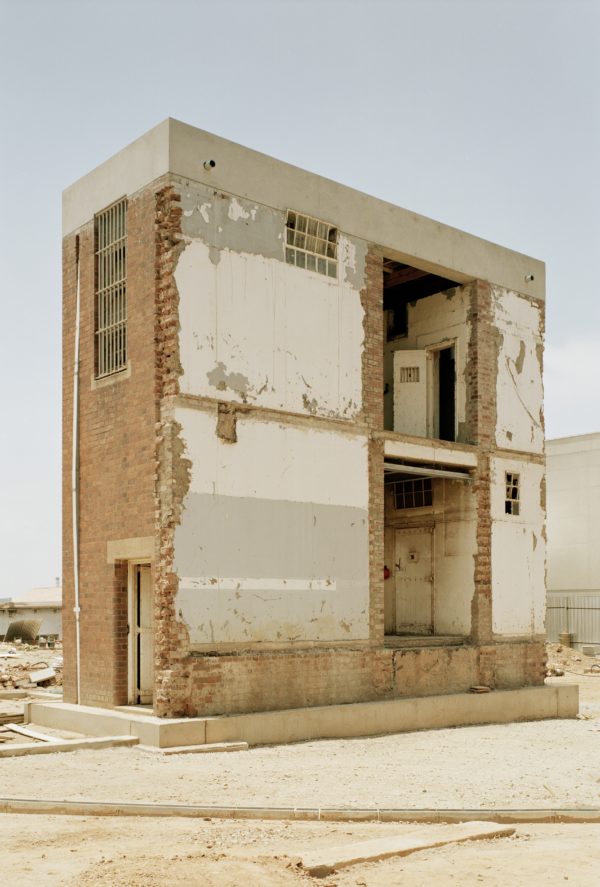Overlooking the poor neighbourhood of Hillbrow in Johannesburg, Constitution Hill was home to a notorious apartheid prison complex that detained both political activists and citizens disobeying pass laws.1 While some of the buildings on the site were retained and turned into museums, the Awaiting Trial Block was demolished to make way for the new Constitutional Court building constructed in 2004.

Court Chamber, South Africa’s Constitutional Court. Urban Solutions and OMM Design Workshop. Johannesburg, South Africa, 2004. Photo Credit: Ann Oredeko.
The court’s commissioners argued that the best location for the building was the exact site of the Awaiting Trial Block, despite arguments against razing the prison building from both the National Monument Council and former detainees. As a compromise, bricks from the demolished building were salvaged and installed in the court chamber as a symbol of moving from a dark past towards a bright future. However well-intentioned a gesture it was, demolishing the Awaiting Trial Block against the wishes of former detainees merely upheld the power structures that the new democracy was meant to destroy. Decolonizing memorials and ensuring that the voices of the marginalized are heard require a dismantling of systems of oppression. Co-opting the monuments of marginalized people to repurpose them, applying one’s own meaning, and deploying them for the benefit of the ruling class reinforce systems of oppression.
Because the prisons’ reach was so large (almost every Black family in Johannesburg knew someone who was imprisoned here), and the treatment so infamous and abysmal, the prison complex was embedded in the collective memory of the residents of Johannesburg and even the country at large. The living conditions of the prisons were abhorrent and many of the people who were imprisoned in the various jails of the complex experienced human rights abuses.

The Awaiting Trial Block was built in 1928 specifically to house black prisoners who were awaiting trial. In December 1956, one hundred and fifty-six activists were detained here on charges of high treason.2 “The Awaiting Trial Block was symbolic of the dehumanising nature of the prison complex since it housed many black offenders detained for petty crimes such as pass law infringements, indeed the petty offenses associated with the colour of their skin.”3 Given the important symbolism of the Awaiting Trial Block, it is no wonder that former detainees and members of the National Monument Council would push back against the court commissioners’ decision to demolish the building. Disagreements between developers and preservationists became so heated that discussions stalled for some time.4 For the National Monument Council, such a move would destroy a national heritage site. Countering these arguments, members of the constitutional court argued that in demanding that the building remained untouched, preservationists were in fact destroying the Awaiting Trial Block rather than preserving it. In deploying such an argument, the court’s commissioners completely ignore the power of allowing such a building to stand as a ruin. The court justices were quick to raze the Awaiting Trial Block to make way for the new court while ignoring the pleas from the National Monument Council and the wider community. The voices of the marginalized were further silenced as the Awaiting Trial Block bricks were salvaged and reinstalled in the court chamber.
Ruins remind us of our past. Their physical presence serves as a portal from the present to the past, offering a glimpse into a time foreign to us.. The Awaiting Trial Block’s enduring presence as a ruin made visible the scars of the past and ensured that the trauma experienced inside its walls was never forgotten, thus amplifying the voices of Black South Africans. Its importance as a monument to the trauma and pain experienced under South African apartheid is made clear by the pushback the court commissioners received when suggesting it be demolished. The decision to demolish the prison and salvage the bricks silences the voices of Black South Africans in order to make way for the court commissioners’ milquetoast statement of unity. Standing as a ruin to South Africa’s apartheid past, the bricks magnify the narratives of those who were once detained behind its walls; however, once removed from their original context and repurposed to promote a message of unity, these voices are silenced.5 How those in power use and frame objects carries weight and has the ability to inscribe these objects with meaning. The South African ruling class colonized the ruins of the Awaiting Trial Block, using them as “object[s] for cosmopolitan contemplation.”6 As members of the political ruling class, the court justices “wielded the power to stake authoritative claims to and about heritage significance.”7 While the ability to shape meaning emerges from positions of power, the very process of meaning-making in turn reinforces and upholds existing power structures. The commissioners erased the memory of Black pain and trauma by imbuing the remaining bricks with a message of South African unity. By doing so, the ruling classes established themselves as the ultimate purveyors of meaning and of the nation's historical narrative. This reinforcement of power structures through meaning-making is by no means unique to the situation at Constitution Hill. It has been a constant feature of systems of oppression for centuries.
CODA: WORKING TOWARDS DISMANTLING SYSTEMS OF OPPRESSION
As the world grapples with how to deconstruct systems of oppression that have existed for centuries, a grassroots art installation popped up outside of Minneapolis’ third precinct, the birthplace of the global protests calling for justice for deaths of unarmed Black people, including George Floyd and Breonna Taylor, at the hands of American police. Bricks from the now-destroyed AutoZone were salvaged and installed on a rack to form an interactive work of art called Brick Rack. While both Brick Rack and South Africa’s Constitutional Court use bricks salvaged from architectural structures, any similarities end there.

Brick Rack, Anonymous. Minneapolis, MN, 2020. Photo credit: @VitalistInt via Twitter.
As an interactive work that celebrates the community occupation of the third precinct, Brick Rack challenges systems of oppression and amplifies the voices of the marginalized. Unlike South Africa’s Constitutional Court, Brick Rack does not salvage the bricks from a ruined building in order to redeploy them in a way that ultimately reinforces power structures. The work allows the ruin to speak. It does not attempt to create new meaning out of the salvaged bricks but instead, as an interactive work that celebrates the community occupation of the third precinct, Brick Rack challenges systems of oppression and amplifies Black voices. In doing so, Brick Rack highlights the injustices perpetrated by the police and the systems of oppression that allow injustice to continue. The work magnifies the voices of the community and points our attention towards the systems that need to be dismantled.
